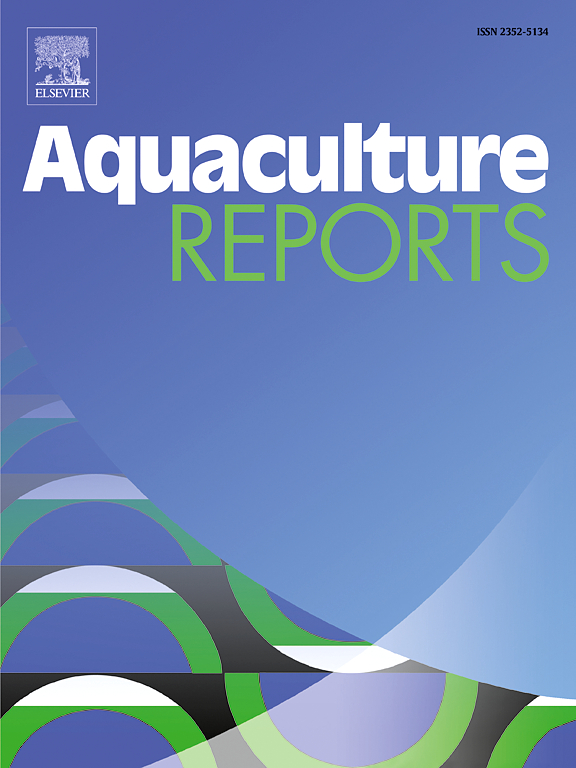饲料蛋白质对外源性过氧化氢注射中华鳖幼龟抗氧化能力和炎症反应的影响
IF 3.2
2区 农林科学
Q1 FISHERIES
引用次数: 0
摘要
本研究评估了日粮蛋白质对中华鳖注射外源过氧化氢(H2O2)时抗氧化酶活性、抗氧化相关酶 mRNA 表达和炎症反应的影响。在为期 8 周的饲养试验中,给中华鳖喂食了蛋白质含量分别为 14.38%、20.41%、26.19%、32.23%、37.63% 和 45.23%的六种饲料,然后给中华鳖腹腔注射 H2O2。高蛋白食物(≥ 26.19 %)产生了以下效果:1)降低血清中天冬氨酸氨基转移酶和丙氨酸转氨酶活性;2)降低脂质过氧化(ROS 和 MDA)水平;3)提高肝脏中 GSH-PX、SOD、T-AOC 和 CAT 的水平;4)激活核因子红细胞 2 相关因子/Kelch 样 ECH 相关蛋白 1(Nrf2/Keap1)信号通路;5)增强 CAT、CuZnSOD、MnSOD、Nrf2、Keap1、GPX1、GPX2、GPX3 和 GPX4 的基因表达;6)抑制白细胞介素-1β、白细胞介素-6、白细胞介素-8 和肿瘤坏死因子α的基因表达水平;以及 7)提高白细胞介素-10 mRNA 的水平。总之,研究结果表明,通过调节 Nrf2 信号通路和炎症,摄入最佳膳食蛋白质水平对 H2O2 介导的氧化损伤具有保护作用。以谷丙转氨酶和谷草转氨酶活性为评价指标,采用折线分析法估算出中华鳖的最佳膳食蛋白质需要量为谷丙转氨酶25.78%,谷草转氨酶26.25%。本文章由计算机程序翻译,如有差异,请以英文原文为准。
Effect of dietary protein on the antioxidant capability and inflammatory response in juvenile Chinese soft-shelled turtles (Pelodiscus sinensis) injected with exogenous hydrogen peroxide
This study estimated the influence of dietary protein on the anti-oxidative enzyme activity, mRNA expression of antioxidant-related enzymes, and inflammatory responses in the Chinese soft-shelled turtle (Pelodiscus sinensis) when injected with exogenous hydrogen peroxide (H2O2). Six diets containing 14.38 %, 20.41 %, 26.19 %, 32.23 %, 37.63 %, and 45.23 % protein were fed to turtles over an 8-week breeding trial, after which the turtles were injected intraperitoneally with H2O2. High protein diets (≥ 26.19 %) produced the following effects: 1) decreased aspartate aminotransferase and alanine transaminase activities in the serum; 2) decreased lipid peroxidation (ROS and MDA) levels; 3) improved the GSH-PX, SOD, T-AOC, and CAT levels in the liver; 4) activated the nuclear factor erythroid 2-related factor/Kelch-like ECH-associated protein 1 (Nrf2/Keap1) signaling pathway; 5) enhanced the gene expression of CAT, CuZnSOD, MnSOD, Nrf2, Keap1, GPX1, GPX2, GPX3, and GPX4; 6) repressed the gene expression level of interleukin-1β, interleukin-6, interleukin-8, and tumor necrosis factor alpha; and 7) improved the level of interleukin-10 mRNA. Overall, the results showed that feeding the optimal dietary protein level played a protective role against H2O2-mediated oxidative damage by regulating the Nrf2 signaling pathway and inflammation. Using broken-line analysis with ALT and AST activities as the evaluation indicators, the optimal dietary protein requirement for the Chinese soft-shelled turtle was estimated to be 25.78 % for ALT and 26.25 % for AST.
求助全文
通过发布文献求助,成功后即可免费获取论文全文。
去求助
来源期刊

Aquaculture Reports
Agricultural and Biological Sciences-Animal Science and Zoology
CiteScore
5.90
自引率
8.10%
发文量
469
审稿时长
77 days
期刊介绍:
Aquaculture Reports will publish original research papers and reviews documenting outstanding science with a regional context and focus, answering the need for high quality information on novel species, systems and regions in emerging areas of aquaculture research and development, such as integrated multi-trophic aquaculture, urban aquaculture, ornamental, unfed aquaculture, offshore aquaculture and others. Papers having industry research as priority and encompassing product development research or current industry practice are encouraged.
 求助内容:
求助内容: 应助结果提醒方式:
应助结果提醒方式:


